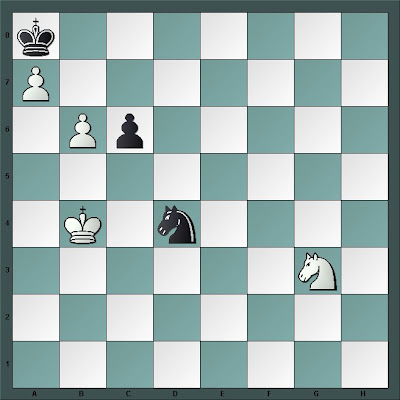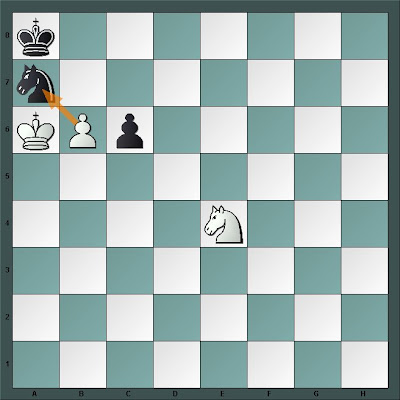I have sent Tomasz Lissowski copies of the notebook. He discovered that, inter alia, Czerniak recorded a game he played -- in a simultaneous exhibition -- against the then-world champion, Alexander Alekhine. Mr. Lissowski had also translated the game score (with Czerniak's notes) into English. (I made a few minor stylistic changes). What's more, using the date (Dec. 2nd) and the location (l’aveugle in Warsaw) given by Czerniak, Mr. Lissowski was able to find the event:
'According to Swiat Szachowy (= Chess World), edited by D. Przepiorka, Alekhine played in Warsaw a simul on 2 December 1928 on 29 boards (including 2 blind, which he "elegantly won").
The total result +19 -4 =6.'
To the best of our knowledge, checking both contemporary and later sources (i.e., Alekhine's game collections, Czerniak's biography), this game has not been made public before. However, such claims are by their nature very hard to prove definitely.
Event: Simultaneous Display by Alekhine
Site: l'aveugle, Warsaw
Date: Dec. 2nd, 1928
White: Alekhine, Alexander
Black: Czerniak, Moshe
Result: 1-0
ECO: D61
Annotator: Czerniak, Moshe
1. d4 e6 2. c4 Nf6 3. Nc3 d5 4. Bg5 Be7 5. e3 c6 6. Nf3 Nbd7 7. Qc2 O-O 8. Rd1 Re8 9. a3

This line was especially popular during the Alekhine - Capablanca match.
(Czerniak overlined a previous note: 'White completely controls the game; Black's position is cramped and he's poorly developed.')
9... Nf8 10. Bd3 Qc7? 11. O-O?

Overlooking 11. Bxf6 would win a pawn: 11... Bxf6 12. cxd5 cxd5 (12... exd5? 13. Nxd5) 13. Nxd5 Qxc2 14. Nxf6+ gxf6 15. Bxc2 (Of course after 11... gxf6 the same, and 14. Nxe7+.)
11... Ng6 12. Rfe1 dxc4 13. Bxc4 h6 14. Bxf6 Bxf6 15. Ne4 Be7 16. Ba2

The most interesting move.
16... b6 17. Ng3 (17. d5! would probably give the better game; after 17... exd5 18. Bxd5 c6 and f7 are weaknesses.) 17... Bd7 18. Ne5! Nxe5 19. dxe5 Rad8 20. f4 c5 21. Rd2 Bc6 22. Red1 Rxd2
White's last move was too passive.
23. Rxd2 Rd8 24. Bb1 g6 25. Ba2

threatening Bxe6
25... Rxd2 26. Qxd2 Qd8 (Not 26... Qd7, which gives up control of the e4 square: 27. Qxd7 Bxd7 28. Ne4) 27. Qc2 (Threatening Bxe6 followed by Qxg6.) 27... Qd7 28. h3 Bb5 (Threatening 29... Qd3!) 29. Bb1 c4 30. Ne4 Qd3 31. Qc1 Qd7 32. Kh2 Kg7 33. Nd6 !?

White gives up a pawn, apparently in order to secure a draw by exchanging Black's active pieces.
33... Bxd6 34. exd6 Qxd6 35. Qc3+ f6 36. Be4 e5! 37. a4 Bxa4?

The beginning of a series of mistakes. 37... Ba6 should have been played, keeping the c-pawn, with a won game.
38. Qxc4 b5? (A second mistake -- a serious one this time. 38... Qd7 was necessary.) 39. Qc8! Qe7??

The final mistake. Black loses. After 39... f5! White probably would not win. The conclusion of the game is played by White in a very sharp and sparkling style.
40. Bd5!! f5 (After 40... Qf8 comes 41. Qb7+ Kh8 42. b3! and White wins.) 41. Qg8+!! Kf6 42. Qh8+!

And Black resigned (1-0), because after 42... Qg7 43. fxe5+ Black loses his queen.



































